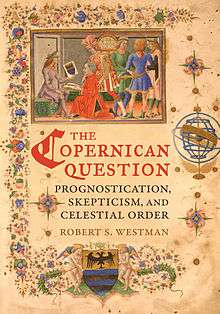The Copernican Question
 | |
| Author | Robert S. Westman |
|---|---|
| Country | United States |
| Language | English |
| Subject | History of Renaissance astronomy, astrology, and scholarship |
| Published | July, 2011. (University of California Press). |
| Media type | Print and E-Book |
| Pages | 704 |
| ISBN | 9780520254817 |
| OCLC | 747411317 |
| 520.94/09031 | |
| LC Class | QB29 W47 2011 |
| Text | at Excerpt available -the book publisher's website |
| LCCN 2009-39562 | |
The Copernican Question: Prognostication, Skepticism, and Celestial Order is a 704-page book written by Robert S. Westman and published by University of California Press (Berkeley-Los Angeles-London) in 2011. This book is a broad historical overview of scholarly responses to Copernicus’s De revolutionibus by the three generations immediately succeeding Copernicus. In other words, the book chronicles the intellectual debates that occurred with each succeeding generation following the publication of Copernicus's book until 1610; when, during this period, prognostication by celestial observation was considered to have practical applications.[1][2][3][4][5][6]
Interpretations
As the book steps through the generations following Copernicus, the variation in application of his work is seen and finally concluding with Galileo's and then Newton's and his contemporaries. One trend is that through each generation, the discourse steps away from viewing astrology as a legitimate discipline. It is Galileo's and Newton's work that eventually distinguishes only astronomy as a mainstream scholarly discipline.[1][2]
Renaissance period astronomy
Also, the book recounts Copernicus’s unseen plan, which was to fortify the "science of the stars", i.e., astrology mixed with astronomy, by buttressing its astronomy, including its computation and measurement foundation, commencing with planetary arrangement.
Additionally, the intention of this book is to unite disconnected modern studies of this historical subject, while ideally completing the studies produced by Edward Rosen, Noel Swerdlow, Owen Gingerich, Barker and Granada. Likewise, it affords a synopsis of Renaissance period astronomy, with its distinctive emphasis on astrology and the arguments and discourses of that period for astrology’s validity, viewed as a crucial segment of systematic scholarly inquiry into the celestial. Furthermore, scholars during the period looked to Copernicus's De revolutionibus for improved astrological prognostication. Therefore, astrology actually "played a central role" in the wide distribution of Copernicus's final publication.[1][2]
See also
- The Scientific Revolution
- The History of science in the Renaissance
- The Renaissance
- History of astronomy
References
- 1 2 3 Omodeo, Pietro D. (2013-02-15). "The Copernican Question: Prognostication, Skepticism, and Celestial Order - by Robert S. Westman". Centaurus. 55: 56. doi:10.1111/1600-0498.272. ISSN 1600-0498. Retrieved 2014-01-12.
- 1 2 3 "The Copernican Question: Prognostication, Skepticism, and Celestial Order: by Robert S. Westman". the Montréal Review. Canada: T.S.Tsonchev Publishing & Design. July 2012. Retrieved 2014-01-12. External link in
|journal=(help) - ↑ Rabin, Sheila J. (Summer 2012). "Robert S. Westman. The Copernican Question: Prognostication, Skepticism, and Celestial Order". Renaissance Quarterly. University of Chicago Press. 65 (2): 559–561. doi:10.1086/667300. JSTOR 667300.
- ↑ Vanden, Steven (March 2013). "The Copernican Question: Prognostication, Skepticism, and Celestial Order by Robert S. Westman". The British Journal for the History of Science. Cambridge University Press. 46 (1): 151–159. doi:10.2307/41809829. JSTOR 41809829.
- ↑ Dear, Peter. "Copernicus and the Science of the Stars". Science. Washington, D.C.: AAAS. 334 (6056): 598. Bibcode:2011Sci...334..598D. doi:10.1126/science.1213727. JSTOR 41351620.
- ↑ "Review: The Copernican Question: Prognostication, Skepticism, and Celestial Order" (Free PDF download available (Academia.edu)). Cambridge University Press. doi:10.1017/S0007087413000137. The British Journal for the History of Science, Vol. 46, pages 151-159.
External links
- Official website
- Heilbron, J. L. (2012). "Robert Westman on Galileo and Related Matters". Perspectives on Science. 20 (3): 379. doi:10.1162/POSC_a_00072.
- Westman, Robert S. (2013). "The Copernican Question Revisited: A Reply to Noel Swerdlow and John Heilbron" (free PDF download). Perspectives on Science. 21: 100. doi:10.1162/POSC_a_00087.
- Westman, Robert S (July 1990), "Chapter 4 Proof, Poetics, and Patronage...", Reappraisals of the Scientific Revolution, United Kingdom: Cambridge University Press, pp. 167–205, ISBN 9780521348041